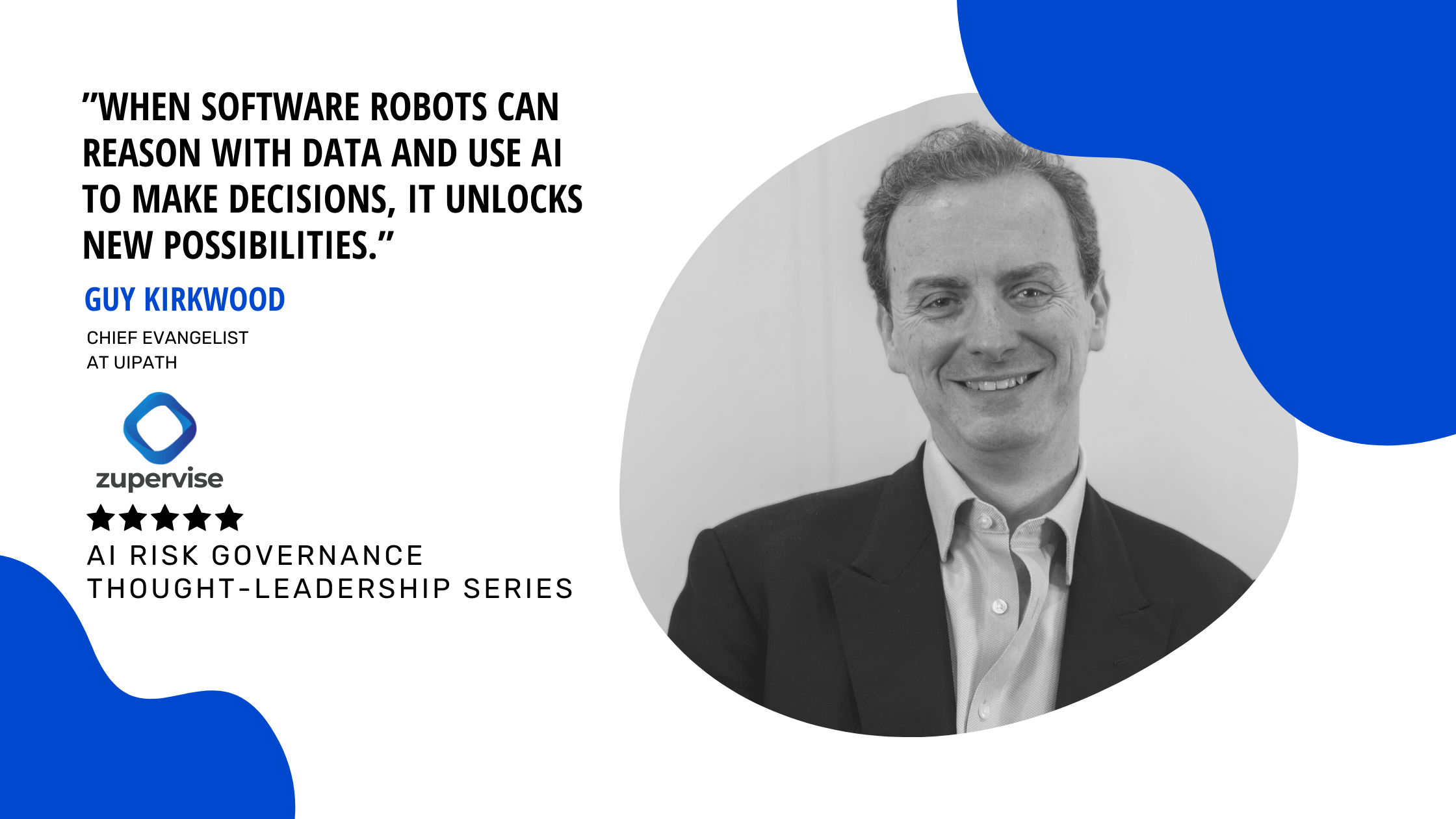
Cognitive services and machine-learning capabilities offer significant scale to Robotic Process Automation (RPA) implementations. Explore this thought-leadership interview with our guest Guy Kirkwood to learn more about what this might mean for your organisation.
What is a software robot?
Put simply, a software robot is a digital assistant that can help carry the burden of unrewarding admin. It can sort and respond to e-mails, prepare automated billing and settlements, process invoices, enter data and move information from one system to another.
The robots are created using Robotic Process Automation (RPA) software to operate a computer just as a human would – but virtually from within the machine. It can take control of a mouse, keyboard and screen in order to complete rule-based and data-intensive tasks. Using Artificial Intelligence (AI), these robots can also read and understand documents in various formats and extract, transfer and process data as needed. Once taught certain processes by humans, they can work 24/7 to undertake repetitive tasks, passing responsibility back when there is a loop in the process that requires a human touch or when an anomaly is identified.
The benefits are that humans, normally doing this type of admin can work alongside the robot to get more done. Alternatively, they can go and do tasks that are more valuable.
What are the challenges in deploying bots in the enterprise?
When first setting out on an automation journey, some of the challenges can be resistance due to lack of awareness regarding the benefits of automation or the lack of RPA skills. Addressing these is an important step if businesses want to make sure their employees are on-board.
If employees aren’t trained on the benefits of the technology, without their buy-in, automation projects may struggle to meet their full potential or be cut short.
Education is the solution. We encourage firms to provide RPA training to as many employees as possible. After all, aren’t we all more likely to embrace what we understand? For example, our clients have run hackathons, provided employees with access to experts and on many occasions have encouraged employees to develop their own automation skills.
This not only allows for a smoother roll-out of automation but employees can also share personal insight into processes, providing a more holistic view of what areas will benefit from automation.
What operational risk mitigation practices would you recommend?
When software robots are deployed in isolation, focusing on one specific task rather than an entire process or workflow, islands of automation emerge. While this siloed approach may help to prove a return on investment to stakeholders in the early stages of an automation journey, it can become dysfunctional, hard to maintain and extremely expensive over time.
Instead, once businesses secure the necessary initial buy-in, they should turn their focus to creating their robots in a more resilient fashion. By taking note of the larger picture, businesses can create an ecosystem of robots that work together.
Focusing on business process management can help to overcome these challenges. Understanding the current and changing processes within a business allows for the creation of bots that operate across departments and functions. In turn, automation becomes a more manageable, company wide effort.
In order for this to be successful, however, it cannot just be an IT project. Employees from all sectors of the business must be involved to provide detailed knowledge of processes and insight into how these interact. This will ensure automation runs smoothly across departments. Furthermore, businesses must deploy intelligent automation, those that use AI and Machine Learning for example, to enhance automation capabilities allowing the technology to reach more stages of a workflow.
For the uninitiated, how do you embed AI into (RPA) workflows?
The increasing ability of machines to learn and to act intelligently has been important to help organisations make strategic decisions. When software robots can reason with data and use AI to make decisions, it is possible to unlock new possibilities that transform entire industries. It means that new levels of productivity can be reached, expanding automation into all sorts of new areas and processes.
We see the growing of AI and RPA technologies inside businesses because, together, they automate large areas of routine work when tasks are fast, known and repeatable.
It’s important to note that we believe in the power of AI, not as a goal in itself, but as a set of technologies which power other products that, in the end, serves your goals.
How should the enterprise effectively govern this AI in automation?
The best way to govern all areas of RPA – including the use of AI – is to have a Centre of Excellence (CoE). This not only embeds RPA deeply and effectively into an organisation, but also redistributes accumulated knowledge and resources across future deployments. The CoE should be responsible for making sure each stakeholder is well informed and comfortable with the rules around the transition to, and use of, software robots.
For example, it should make clear how employees should run and publish automation, what limitations there might be for people, what approvals they need and how they can assure quality.
How do you see the future of RPA in a post-Covid world?
Covid-19 has undoubtedly accelerated the adoption of RPA and proven its value. Businesses have used the technology to boost efficiency and digitise processes to reduce the need to be in the office. It’s also allowed them to deal with increasing workloads in areas such as customer service and data entry. Now that organisations are tuned into the benefits of RPA, its adoption will only continue to grow in a post-Covid world.
Guy Kirkwood is Chief Evangelist at UiPath, a global leader in enterprise Robotic Process Automation (RPA) software. In his role, Guy communicates the company’s vision to customers, partners, and analysts, and brings their insights back into the development, product, marketing, and sales teams.
All opinions expressed by this interview participant are solely their personal opinions and do not reflect the opinions of their current or past employers.


